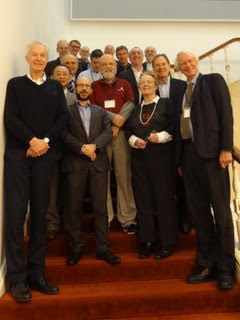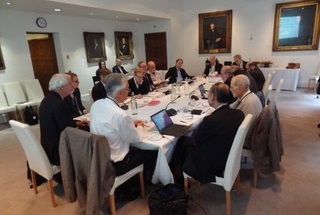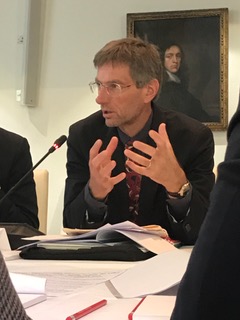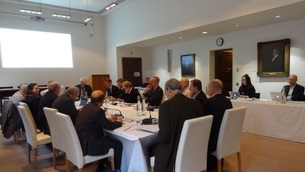Cooperative Security, Arms Control and Disarmament
Director's Introduction to the London Report
November 09 - 10, 2017
London

It gives me great pleasure to introduce the summary report and conclusions of a High Level Meeting that the Toda Peace Institute in collaboration with the CRS, NUPI and the University of Otago organised in London in November 2017.This was the first of what we hope will be many conversations aimed at bridging the gap between the proponents of the Nuclear Prohibition Treaty and existing Nuclear Treaties such as the NPT. This meeting was initiated in order to work out ways in which nuclear powers and their allies and non-nuclear powers might make 21st century progress on ways of guaranteeing the safety and non-use of nuclear weapons while working for their total abolition.
On 7 July 2017, 122 states voted to adopt a new Nuclear Weapons Prohibition Treaty (hereafter, Ban Treaty). It is the first treaty to ban the possession, transfer, use and threat of use of nuclear weapons, thereby closing the legal gap on the prohibition of all classes of weapons of mass destruction. It was opened for signature in the UN General Assembly on 20 September and will come into effect 90 days after 50 states have ratified it. More than 50 have already signed.
While advocates of the Ban Treaty have consistently underlined the complementarities with the NPT, the five nuclear weapon states have argued that the new treaty is a potential threat to the credibility and authority of the NPT. After the vote on 7 July, in a joint press statement, the ambassadors of the US, UK and France said they had not taken part in the negotiations and did not intend to sign it because it 'disregards the realities of the international security environment' and 'is incompatible with the policy of nuclear deterrence, which has been essential to keeping the peace in Europe and North Asia for over 70 years'.
Western allies, including NATO members in Europe and Australia, Japan and South Korea in the Asia-Pacific, joined them in criticising the treaty as ineffectual, impractical and lacking credibility. This has resulted in an unusual situation where a majority of countries that are among the best global citizens and defenders of the United Nations find themselves actively opposed to a multilateral treaty negotiated by a duly mandated UN conference.
This London conference was initiated to try and address this gap and was aimed at identifying areas of policy agreement and disagreement around issues such as safeguards standards; testing; stationing; the meaning and scope of assistance and encouragement to other states engaged in activities prohibited under the NWPT (for example support for nuclear deterrence postures); institutional arrangements for review, amendments, verification and enforcement; and linkage with the non-NPT nuclear-armed states.
It is in the interests of both nuclear weapon states and non-nuclear weapon states to address the normative and political divisions between these two global regimes in order to make progress on ways of ensuring that nuclear risk and catastrophe can be removed from the list of 21st century existential threats. The meeting that this report was based on brought together nuclear energy, weapons and strategic experts and officials from both sides of the debate. These were their conclusions which are now being turned into more detailed Policy Briefs initiated by the Toda Peace Institute, the APLN, the ELN and Nupi. These in turn will provide background information for a range of Track One, Track 1.5 and Track 2 discussions over the next twelve months. I would like to thank Professor Hugh Miall for his writing of this Summary Report and Professor Ramesh Thakur for his insights on these issues, commitment to the project and his willingness to use the APLN network to deepen and strengthen the debates started in London.
Kevin P Clements,
Director, Toda Peace Institute.
BRIDGING THE GAP BETWEEN BAN TREATY SUPPORTERS AND STEP-BY-STEP APPROACHES TO ELIMINATING NUCLEAR WEAPONS
8-10 November, 2017 London
Policy Conclusions of the High-Level Meeting on "Cooperative Security: Rethinking Nuclear Arms Control and Disarmament in the 21st Century", London, 8-10 November 2017
Executive Summary

Nuclear arms control and disarmament are in crisis. Existing agreements, including the Intermediate Nuclear Forces Treaty, the Comprehensive Test Ban Treaty and the Non-Proliferation Treaty are under threat. Sharp divisions have appeared between advocates of arms control and disarmament who seek a step-by-step approach to arms control by the nuclear weapons states, and proponents of the Treaty on the Prohibition of Nuclear Weapons (the Ban Treaty). Ban Treaty supporters argue that the step-by-step approach is not working. Advocates of incremental progress argue that a Treaty signed only by non-nuclear weapons states is not helpful. To address this disagreement, the Toda Institute convened a high-level international meeting with proponents of each position.
The meeting agreed on criteria that can be used to assess whether arms control and disarmament measures are helpful, and explored ways in which progress could be made towards the agreed objective of eliminating nuclear weapons. The meeting identified practical steps which would be capable of generating further momentum. The steps include:
- Working to eliminate an entire class of nuclear weapons that are particularly destabilising: nuclear-armed cruise missiles.
- Working towards 'diamond standards' on verification, going beyond NPT safeguards and the Additional Protocol, for a world near or at zero nuclear weapons.
- Exploring the issues of trust and breakout in a near zero or nuclear free world.
- Bringing together lawyers and security specialists to consider a return to the ICJ in the light of new evidence on the humanitarian consequences of the use of nuclear weapons.
- Disinvestment from companies producing nuclear weapons.
- Seeking negative assurances and de-alerting nuclear weapons.
- Educational measures to widen public awareness of the humanitarian consequences of nuclear weapons.
- Involving full and equal participation of women in this process.
Purpose

The Toda Institute convened this high-level meeting to discuss the current prospects and ways forward out of the current impasse in nuclear arms control and disarmament. It brought together diplomats and former officials representing nuclear weapons states, 'nuclear umbrella states' and neutral non-nuclear states, former senior officials from the UN and the IAEA, representatives of NGOs in favour of and against the Ban Treaty and academics.
1. Arms Control and the Prospects for Cooperative Security
The Intermediate Nuclear Forces Treaty (INF), the Non Proliferation Treaty (NPT) and the Comprehensive Test Ban Treaty (CTBT) are hanging by a thread. The US has alleged that Russia is deploying cruise missiles in Europe and in response the US is considering a new ground-launched nuclear cruise missile and withdrawal from the INF. Republicans in the House have voted against the CTBT. The NPT agreement is increasingly frail. Relations between Russia and the West have sharply deteriorated, and the Ukraine crisis has abrogated the principle of respect for borders which underpins existing arms control agreements. US withdrawal from the Joint Comprehensive Plan of Action (JCPOA) agreement has put the containment of the Iranian nuclear programme in jeopardy. All nuclear states are vigorously modernizing their nuclear weapons. More than $1.2 trillion has been committed to new nuclear weapons programmes over the next 30 years. The Chemical Weapons Convention, the Conventional Forces in Europe agreement and the Open Skies Agreement are all under pressure. Populism, nationalism and renewed great power competition are threatening the multilateral international order.
In this context, what is the way forward in arms control and disarmament? Who should provide leadership? Is the right approach incremental or prohibitionist, top down or bottom up, treaty-based or norms-based?
Participants argued that it is still possible to preserve the achievements that have been made. A deal is possible on INF. Strategic stability talks continue and the US and Russia have complied so far with their START obligations. We know from history that things can change for the better, but for now we need time, a willingness to compromise, face-saving solutions, a settlement in Ukraine, protection of existing agreements and a willingness to place international relations on the basis of cooperative instead of competitive security. Arms control and disarmament need greater public support and attention.
The US and Russia are failing to provide leadership. The EU is based on security cooperation and has opportunities to promote it further, for example in Eurasia. But the EU is divided and has failed to be robust in dialogue on arms control matters with the United States. China has spoken in cooperative security terms and could step up to a leadership role in this field, but so far has avoided doing so. Could a US-China condominium play a role? Could a coalition of willing countries act? Does the initiative lie with neutral states, such as Ireland and Austria?
What is the role of faith leaders, physicians, musicians? Ultimately it will be the people who will force change, and governments who will need to carry it out. Civil society and opinion leaders have a crucial role to play in educating the public and mobilising concern. A groundswell of public opinion and vigorous actions by governments are needed.
2. Which Way Forward? - Incrementalists versus Prohibitionists.

Supporters of an incremental approach argue that it is essential to engage the nuclear weapons states in measures to reduce nuclear weapons, and to deal first with the most destabilising risks. The step by step approach has credibility among knowledgeable elites and decision-makers in the nuclear weapon states and the 'umbrella states' which are protected by nuclear weapons. A nuclear drawdown will only happen under a new Treaty, elaborating detailed verification and enforcement measures, negotiated by the nuclear weapons states themselves, in collaboration with their allies. The Ban Treaty has created a rupture. It could weaken the NPT, the UN and the IAEA. It creates polarisation between those who are versed in the technicalities of deterrence and those who take the moral high ground. The priority should be to focus on winnable campaigns in the nuclear weapons and nuclear umbrella states. These include: retaining the CTBT, limiting the extent of nuclear modernisation, preserving the INF, seeking negative security assurances, de-alerting nuclear weapons, working on effective verification, working on nuclear safety and the safety of nuclear arsenals, seeking bilateral and multilateral commitments to no first use, and pursuing deep reductions in the US and Russian arsenals.
Supporters of the Ban Treaty argue that the 'step-by-step' approach has failed. Of critical importance is the new understanding of the humanitarian consequences of nuclear use. The most dramatic evidence is about the impact of nuclear war on the climate. Incontrovertible evidence, confirmed by the world's leading atmospheric scientists, indicates that the detonation of even a tiny fraction of the world's nuclear arsenals, such as an limited exchange of 100 Hiroshima-size weapons between India and Pakistan, would lower global temperatures and threaten the food security of hundreds of millions of people. A larger exchange between the US and Russia would cause a nuclear winter which would decimate global agriculture. Since all people and states would be affected by even a limited nuclear exchange, it is justified for non-nuclear weapons states to take the lead. A nuclear weapon free world is a shared UN objective, that all member states have a responsibility to pursue. In the absence of leadership by the nuclear weapons states, the non-nuclear weapons states formulated this Treaty, which is open for all to sign. The Ban Treaty is the first to extend the prohibition of other types of inhumane weapons to nuclear arms. The use of nuclear weapons would have such devastating humanitarian consequences that threatening their use is unacceptable. The Ban Treaty therefore aims to stigmatise and delegitimize these weapons and the deterrence policies that are based on them. It is the first successful UN nuclear disarmament treaty in 21 years, and has been accepted by the most inclusive body in the UN system. It is reinvigorating the discussion on nuclear disarmament, and it aims to complement, not undermine, the NPT.
Can the Ban Treaty and a step-by-step approach be reconciled? Participants felt it should be possible. In the case of other prohibited weapons, such as landmines, incremental steps had to be made to get rid of weapons after they had been prohibited. It was accepted that the text of the Ban Treaty could be improved in future reviews, for example with regard to verification provisions. In the near term, it is unlikely that the Ban Treaty will attract support from the governments of nuclear weapons states or of nuclear umbrella states. The Ban Treaty may present a worthwhile challenge to deterrence thinking, but NATO members cannot both accede to current NATO doctrine and accept the Ban Treaty. The danger of the Ban Treaty is therefore that it could freeze the present division between nuclear and non-nuclear weapon states.
Two principles were outlined, for assessing the success of any nuclear arms control and disarmament measure. First, does it reduce the number of nuclear weapons and get us closer to eliminating them altogether? Secondly, does it reduce the risk of nuclear weapons being used while we are on the road to eliminating them? The Ban Treaty may help to reinforce the taboo on nuclear weapons, which needs reinforcement. The Ban Treaty could gain standing over time, for example if it were linked to a negative security assurance such as the Reagan-Gorbachev pledge, that "a nuclear war can never be won and should never be fought". The Ban Treaty can be effective in mobilising public opinion and delegitimizing nuclear weapons, if it is reinforced by civil society. Ban Treaty supporters seek elimination of nuclear weapons through a treaty process, and therefore see the dichotomy between the Ban Treaty and a step-by-step approach as a false choice.
It has been argued that the Ban Treaty weakens NPT safeguards and makes the NPT Review process more complicated. But resistance to NPT safeguards predates the Ban Treaty. The 'gold standard' for nuclear safeguards has been the comprehensive safeguards of the NPT Treaty based on INFCIRC/153 and the Additional Protocol of 1997. But a number of non-aligned states have resisted the Additional Protocol, on the grounds that this would be a concession while nuclear weapons states have failed to meet their Article 6 commitments. Further steps on risk reduction, elimination of weapons, verification and safeguarding are necessary and it is incumbent on nuclear weapons states and non-nuclear weapons states to seek progress towards them.
3. Practical Steps and Policy Proposals

While exploring measures that proponents of the Ban Treaty and advocates of a step-by-step approach could agree on, participants identified a number of practical policy measures that are worth exploring now to build renewed momentum towards the shared goal of eliminating nuclear weapons.
(i) A ban on ground launched nuclear-armed cruise missiles.
The INF treaty bans nuclear-armed cruise missiles in Europe, but new developments globally are creating risks from these weapons. For example, Pakistan has tested a submarine-launched cruise missile. It would be a useful next step to eliminate this whole class of nuclear-armed cruise missiles. There is support in the US, the UK and China for such a step. It needs a coalition of ten to fifteen countries to take it forward, but there is much preparatory work to be done on the details of verification and the mechanics of implementation.
(ii) 'Diamond standards' on verification.
As the world approaches zero nuclear weapons, the requirements for both trust and verification increase. It would be useful to explore 'diamond standards' in verification that go beyond the existing 'gold standards' of NPT Safeguards and the NPT Protocol. Proposals for societal as well as state verification are worth considering further.
(iii) A study of trust and the problem of breakout in a nuclear-weapons free world
How can trust-building match verification in the process of getting towards zero? How can trust-building be embedded in cooperative security arrangements, and deal with enforcement issues in preventing breakout? Is there a role here for the revival of transnational or supranational regulation of nuclear weapons?
(iv) Bringing together lawyers and security specialists to consider the legality of nuclear weapons in the light of new evidence of humanitarian consequences of their use
The new evidence of humanitarian consequences raises in a fresh way the legal issues which were inconclusively addressed in the case before the ICJ in 1996. It would be useful to bring together lawyers and security specialists to consider legal aspects of how the use of nuclear weapons can be prevented, and also to assess the advisability of returning to the ICJ in the light of the fresh evidence.
(v) Disinvestment from companies involved in the production of nuclear weapons.
One way in which non-nuclear states and non-state actors can contribute is by disinvesting from companies involved in nuclear weapons production. The Nordic countries have seen initiatives in this area. This is a worthwhile area for further study.
(vi) Negative security assurances and de-alerting nuclear weapons.
It was agreed that reducing the risk of use of nuclear weapons is a high priority, particularly in the context of inadequate safeguards by new nuclear weapons states, and the development of new classes of destabilising weapons. If no first use pledges are beyond reach, it is worth exploring negative security assurances such as the Reagan-Gorbachev pledge. These could be agreed on a bilateral or multilateral basis. Agreements to take nuclear weapons off high-alert status would reduce risk and are a high priority.
(v) Educational measures to widen public awareness of the humanitarian consequences of nuclear weapons.
Participants all agreed that campaigns to raise public awareness and concern about the threats posed by nuclear weapons, particularly in the light of the evidence of humanitarian consequences, are vital. More can be done to raise awareness for example of the consequences of the use of nuclear weapons in particular regions. It is desirable to reach out to faith communities and youth, and to use music and films as well as texts and speech. There is a role here for scientists, physicians, civil society, and opinion leaders.
(vi) Involving the full and equal participation of women in this process.
Many of the discussions in the arms control area are arcane and exclusive, although women have been fully involved in public efforts for disarmament. Participants agreed that it is essential to involve full and equal participation of women in the arms control and disarmament process.
(vii) A plan of action for the 2019 Review Conference of the Ban Treaty
Supporters of the Ban Treaty should present a plan of action addressing the most critical issues in the Ban Treaty, taking on board the criticisms of the 'incrementalists'. This might include considering ways the Ban Treaty can contribute to achieving a final NPT consensus document, and future elaboration of bridge-building between proponents and opponents of the Ban Treaty
(viii) Further steps on incremental reductions
In considering further reductions in nuclear forces, it is necessary to address asymmetries in forces. For example, missile defences and missiles should be regulated together, perhaps by trading three ABM interceptors for one missile. This is an area worthy of exploration by those pursuing a step-by-step approach. There also needs to be a process to get the CTBT to enter into force, despite the eight Annex 2 countries that have not ratified it. Another proposal was for proactive planning for a programme to dismantle the chemical weapons from North Korean munitions, under international control. It is essential also to develop a process, beyond the Permanent Five members of the Security Council, to bring the other four nuclear weapons states into an arms control and disarmament process.
The Toda Institute is planning a series of policy briefs and follow-on meetings to take these issues further.